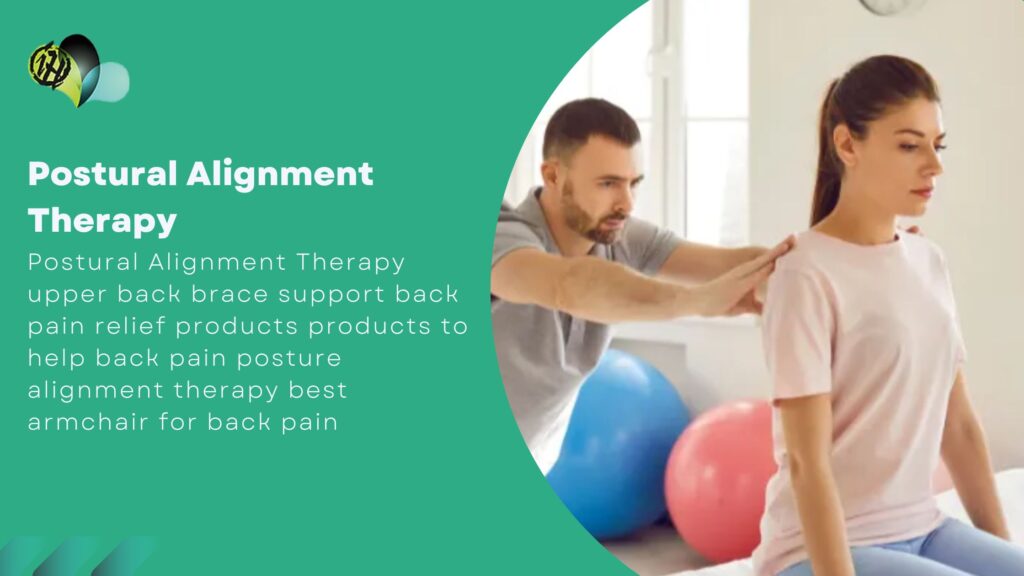“Postural Alignment Therapy upper back brace support back pain relief products products to help back pain posture alignment therapy best armchair for back pain.” This is more than a list of tools; it’s a reminder that every choice we make (from how we sit to what we use) ties back into spinal health and how we move day to day.
Your posture is the foundation of how your body functions. When your alignment is off, it can lead to discomfort, reduced mobility, pain, and, over time, more serious issues. Postural Alignment Therapy is one of the most effective ways to keep your musculoskeletal system balanced, protect your spine, and maintain quality of life. Here we dive into why this therapy matters, what it does, what the science says, and how Integrative Health Inc. provides this crucial service.
What Is Postural Alignment Therapy?
Postural Alignment Therapy refers to a suite of approaches aiming to restore and maintain ideal alignment of the spine, shoulders, pelvis, and joints. It typically includes:
- Assessment: Evaluating how you stand, sit, and move. Looking for curves of the spine (kyphosis, lordosis), shoulder position, pelvic tilt, and asymmetries.
- Corrective Exercises: Specific movements that strengthen weak muscles and stretch tight ones.
- Manual Therapy: Techniques like chiropractic adjustments, massage, and myofascial release to address rigid or misaligned structures.
- Ergonomics & Lifestyle Guidance: Adjusting your work station, chairs, sleep surfaces, and movement habits to support good posture.
- Supportive Aids: Sometimes using devices (e.g., upper back brace support) or products to help with back pain to reinforce alignment during daily tasks.
Why Your Spine Needs Proper Alignment
1. Structural Health and Prevention of Degeneration
Misalignment increases uneven wear on spinal discs, joints, and ligaments. Over time, this contributes to degenerative disc disease, osteoarthritis, and herniation.
2. Pain Management and Relief
Back pain, neck pain, or discomfort in the shoulders often arises because muscles are overworking to compensate for misaligned structures. Proper alignment helps reduce that overuse, alleviating pain.
3. Improved Function, Mobility & Movement Efficiency
When your spine, hips, and shoulders are well aligned, movement is smoother. You have better biomechanical leverage, balance, and less fatigue doing everyday tasks.
4. Nervous System Health
The spine houses and protects your spinal cord. Misalignment can impinge on nerve roots, contribute to pinched nerves, and affect nerve signaling. This can mean tingling, numbness, or decreased organ function in some cases.
5. Mental Health, Posture, Confidence & Breath
Good posture affects how you feel. Standing or sitting upright helps breathing, improves mood, reduces feelings of stress, and supports a confident presence.
Components of Postural Alignment Therapy
Here are the components that make up a complete therapy approach:
- Assessment & Diagnostics: Motion analysis, gait scan, posture photography, sometimes diagnostic imaging or custom orthotics.
- Core & Stabilizer Muscle Training: Work on muscles like the transversus abdominis, pelvic floor, glutes, rhomboids, etc.
- Flexibility & Mobility Work: Stretching tight hip flexors, hamstrings, chest muscles, and improving thoracic mobility.
- Manual Adjustments & Soft Tissue Work: Chiropractic adjustments, massage therapy, myofascial release.
- Ergonomics / Habit Education: How to sit, how to stand, how to lift, what type of chair or best armchair for back pain, and how to use an upper back brace support properly.
- Supportive Products / Tools: Products to help with back pain, such as upper back brace support, posture alignment therapy tools, and possibly ergonomic furniture or the best armchair for back pain.
How Postural Alignment Therapy Compares to Other Approaches

Many people try isolated treatments such as pain meds, temporary brace use, or stretching without addressing the root alignment issues- relief is often temporary. Postural Alignment Therapy is holistic and integrative:
- It doesn’t just mask pain; it aims to correct contributing factors.
- It uses both conservative (exercise, manual therapy) and supportive tools (back pain relief products, braces, ergonomic furniture).
- It involves patient participation, regular movement, attention to posture, and lifestyle changes.
When Is Postural Alignment Therapy Especially Important?
- If you experience chronic back, neck, or shoulder pain
- If you have had injuries (sprains, strains, disc issues)
- If you sit long hours (office workers, drivers) or stand in awkward positions
- If you have noticed poor posture (rounded shoulders, forward head posture, sway back, uneven hips)
- If you are aging, and spinal flexibility or strength has diminished
Products and Supports: Bringing It All Together
There are supportive aides that, when used properly, complement therapy:
- Upper back brace support – helps reinforce proper shoulder and thoracic alignment, especially when sitting or performing repetitive tasks.
- Back pain relief products – such as lumbar supports, foam rollers, posture correctors, or ergonomic seat cushions.
- Products to help back pain – using high-quality materials, proper sizing, and used in conjunction with movement and therapy.
- Best armchair for back pain – having lumbar support, adjustable features (height, recline, armrests), firm but comfortable padding, good thoracic and pelvic support.
These products don’t replace therapy—they amplify its effect.
The Science Behind Postural Alignment Therapy
- Muscle Imbalance Theory: When one group of muscles is tight (e.g., chest, upper traps) and opposing ones are weak (e.g., mid-back, deep core), posture shifts. Therapy rebalances.
- Joint Loading and Biomechanics: Proper alignment ensures even load across joints and discs, reducing wear.
- Neurosensory Feedback & Proprioception: Brain and sensory receptors adjust habits when posture is corrected and movement patterns improved.
- Plastic Changes Over Time: With consistent therapy, muscle lengths and strengths shift; connective tissue reshapes; alignment improves more permanently.
Daily Life Examples: How Posture Affects Your Function
- At Work: Sitting all day without support strains the lumbar spine. Without posture awareness, you may slouch, leading to low back pain.
- Driving: Forward head posture, hunching, and lack of lumbar support create fatigue and stiffness.
- Lifting Objects: Improper posture transfers loads to lumbar discs; proper core stabilization protects against injury.
- Sleep: Poor mattress or pillow alignment disturbs spinal curves, leading to morning stiffness.
- Leisure Activities: On phones/computers, forward head posture; on couches without proper back support stresses the thoracic spine.
What to Expect in Postural Alignment Therapy at Integrative Health Inc.

Here’s how we at Integrative Health Inc. deliver this service in a comprehensive, patient-centered way:
- Initial Consultation & Assessment
We begin with a detailed intake: movement, posture, gait analysis, any past injuries or surgeries, and daily habits. This gives us a baseline to tailor therapy. - Customized Treatment Plan
Depending on findings, you’ll receive a plan combining various modalities, such as chiropractic alignment, massage therapy, exercises, stretches, and possibly custom orthotics. - Use of Orthotics or Supports
If needed, we may suggest upper back brace support or other products to help with back pain to be used temporarily to assist until your muscles and alignment are stable. - Rehabilitation, Exercises & Stretches
You’ll be guided through core strengthening, mobility routines, and daily posture practice. - Ergonomic & Lifestyle Guidance
From selecting the best armchair for back pain to adjusting your workspace, daily movement, and habits are modified to support alignment. - Follow-up & Reevaluation
We monitor progress, adjust your plan, and ensure improvements are maintained.
Why Choose Integrative Health Inc for This Service?
- Holistic Approach: We don’t just treat symptoms—we evaluate the whole person, including posture, movement habits, and lifestyle.
- Multidisciplinary Expertise: Our team includes chiropractic therapy, massage, rehab specialists, functional medicine, custom orthotics, and ergonomic evaluation, all working together.https://integrativehealthinc.com/
- State-of-the-Art Assessment Tools: We use body engineering, gait scan, and detailed physical assessments.https://integrativehealthinc.com/
- Personalized Therapy Plans: No “one-size fits all.” Your plan is based on your unique alignment, strength, flexibility, and goals.
- Supportive Products and Tools: When appropriate, we recommend or provide back pain relief products, upper back brace support, and ergonomic equipment.
- Focus on Long-Term Results: Our therapy isn’t just for short-term relief; it aims to create lasting alignment, function, and comfort.
How to Integrate Postural Alignment into Your Daily Routine
- Morning Check-In: Assess how you slept: did your neck or back feel stiff? Use that as feedback for bedding and pillow setup.
- Work Breaks: Every 30–45 minutes, stand, stretch, reset posture.
- Seating Matters: Choose a chair (or best armchair for back pain) with good lumbar and thoracic support; use cushions or braces if needed.
- Use of Supportive Products Wisely: Use upper back brace support when posture is hard to maintain, just don’t become over-reliant.
- Regular Movement and Strengthening: Core work, thoracic mobility, scapular stability exercises.
- Ergonomic Adjustments: At your desk, in the car, at home, monitor height, keyboard placement, and foot support.
Common Myths and Misconceptions
- “Perfect posture means rigidity.” False. Good posture allows fluidity and alignment with mobility.
- “Braces fix posture entirely.” They assist, but strength, movement, and habit are required.
- “If it doesn’t hurt, my posture is fine.” Not many alignment issues develop into pain later; early intervention can prevent problems.
- “Only people with back pain need posture therapy.” Even if you don’t have pain, posture affects performance, health, breathing, and long-term structural integrity.
Summary & Next Steps
- Postural Alignment Therapy is essential for spinal health, pain prevention, and maintaining daily function.
- Whether you use back pain relief products, an upper back brace support, or choose the best armchair for back pain, these tools should work in tandem with therapy.
- Early assessment, consistent practice, and lifestyle changes make the biggest difference.
- If you’re in the United States and looking for top-tier care, Integrative Health Inc. offers the expertise, tools, and individualized plan to support your journey toward better posture and spinal health.
Conclusion
In a world where so many of our daily activities encourage slouching, hunching, or settling into poor alignment, investing in Postural Alignment Therapy upper back brace support back pain relief products products to help back pain posture alignment therapy best armchair for back pain is investing in long-term spinal health and daily function. At Integrative Health Inc., we believe your spine deserves attention just when pain shows up, but as a cornerstone of wellness.
If you want to learn more or schedule an assessment, reach out to us. Your spine, posture, and daily comfort will thank you.

